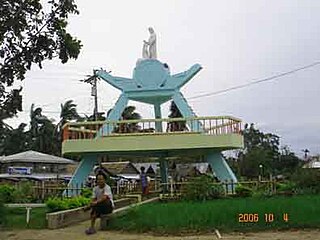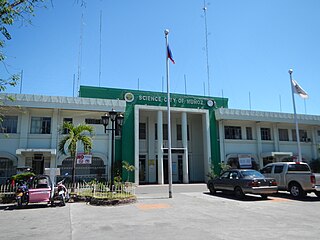Gumaca | |
|---|---|
| Municipality of Gumaca | |
 Muralla Boulevard at the mouth of Pipisik River | |
 Map of Quezon with Gumaca highlighted | |
Location within the Philippines | |
| Coordinates: 13°55′16″N122°06′01″E / 13.921°N 122.1002°E | |
| Country | Philippines |
| Region | Calabarzon |
| Province | Quezon |
| District | 4th district |
| Founded | November 13, 1582 |
| Barangays | 59 (see Barangays) |
| Government | |
| • Type | Sangguniang Bayan |
| • Mayor | Webster D. Letargo |
| • Vice Mayor | Rico J. Bañal |
| • Representative | Keith Micah DL. Tan |
| • Municipal Council | Members |
| • Electorate | 46,520 voters (2022) |
| Area | |
| • Total | 189.65 km2 (73.22 sq mi) |
| Elevation | 38 m (125 ft) |
| Highest elevation | 181 m (594 ft) |
| Lowest elevation | 0 m (0 ft) |
| Population (2020 census) [3] | |
| • Total | 71,942 |
| • Density | 380/km2 (980/sq mi) |
| • Households | 19,260 |
| Demonym | Gumacahin |
| Economy | |
| • Income class | 1st municipal income class |
| • Poverty incidence | 7.70 |
| • Revenue | ₱ 273.1 million (2020) |
| • Assets | ₱ 474.4 million (2020) |
| • Expenditure | ₱ 257.7 million (2020) |
| • Liabilities | ₱ 111.7 million (2020) |
| Service provider | |
| • Electricity | Quezon 1 Electric Cooperative (QUEZELCO 1) |
| Time zone | UTC+8 (PST) |
| ZIP code | 4307 |
| PSGC | |
| IDD : area code | +63 (0)42 |
| Native languages | Tagalog |
| Website | gumaca |
Gumaca, officially the Municipality of Gumaca (Tagalog : Bayan ng Gumaca), is a 1st class municipality in the province of Quezon, Philippines. According to the 2020 census, it has a population of 71,942 people. [3]
Contents
- History
- Geography
- Barangays
- Climate
- Demographics
- Economy
- Transportation
- By land
- Tourism
- San Diego de Alcala Fortress (Kutang San Diego)
- Lamon Bay
- San Diego de Alcala Cathedral
- Plaza Rizal
- Muralla
- Culture
- Araña't Baluarte Festival
- Cultural tour
- Folk dances
- Government
- Local government
- Municipal mayors
- Notable
- References
- External links
It is located at the mouth of what is now known as Pipisik River and nestled at the foot of the Sierra Madre range. The town is widely known as a heritage town due to the many ancestral houses and old structures that abound in the area, including a fortress from the Spanish era. The local government is currently conserving these heritage structures for future generations.
Gumaca is 66 kilometres (41 mi) from Lucena and 196 kilometres (122 mi) from Manila.





























